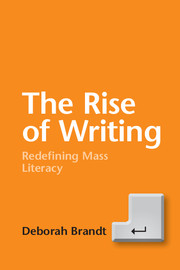Introduction: the rise of mass writing
Published online by Cambridge University Press: 05 January 2015
Summary
In meetings of the First Federal Congress in June 1789, as James Madison experimented with wording that would eventually become the First Amendment, he proposed to include the following:
The people shall not be deprived or abridged of their right to speak, to write, or to publish their sentiments.
Roger Sherman, representative from Connecticut, concurred in a committee report filed in the following month, declaring that among the “natural rights” of the people are “speaking, writing, and publishing their sentiments with decency and freedom.”
But by the time that the Bill of Rights was enacted, references to the people’s right to write and publish had been subsumed into what we know today as the free-speech clause of the First Amendment, which states simply that: “Congress shall make no law…prohibiting the freedom of speech, or of the press.”
But by the time that the Bill of Rights was enacted, references to the people’s right to write and publish had been subsumed into what we know today as the free-speech clause of the First Amendment, which states simply that: “Congress shall make no law. . . prohibiting the freedom of speech, or of the press.”
Why the people’s explicit right to write was excised from the language of the Bill of Rights is lost to history. Perhaps it was merely to repair a redundancy, as writing is a form of speech.
- Type
- Chapter
- Information
- The Rise of WritingRedefining Mass Literacy, pp. 1 - 15Publisher: Cambridge University PressPrint publication year: 2014

